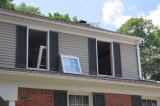Upgrade Your Home for Greater Energy Savings

Replacement windows can prevent energy from escaping your home.
When considering upgrading your home or business, there are several areas or features in your home that can be easily upgraded with energy-efficient products, including:
- Appliances
- Light bulbs
- Insulation
- Windows and doors
Appliances & Light Bulbs
Energy-efficient appliances can cut your energy costs by up to 30%. Most energy you use in your home is produced by power plants burning fossil fuels, which then creates pollution. Did you know that your home generates more greenhouse gas emissions than an automobile? The media is always encouraging consumers to cut down on automobile pollution, but you rarely hear about the pollution your home is emitting. A more energy-efficient home would waste less.
The biggest portion of energy being spent in the home is on your heating and cooling, unsurprisingly. About half of your energy cost is a result of either heating or cooling your home. The water heater takes about 11 percent, and is followed closely by the washer and dryer. A great way to upgrade your water heater is to install a tankless water heater, which is known for its amazing energy-saving capabilities. Typical lighting for a home is about 7%, and your refrigerator accounts for 6%. The rest is taken up by smaller appliances such as your television, computer and microwave. Speak to an electrician about finding ways to decrease your energy output.
By choosing products that are energy-efficient, you can reduce how much energy you use. By doing so, you reduce emissions of greenhouses gases, as well as reducing your monthly energy costs. You actually help the environment by helping yourself. So, consider using energy-efficient appliances and using fluorescent (or CFL) lights.
Insulation
How does insulation help your home to become more energy-efficient? Actually, insulation helps reduce the energy costs of cooling your home and heating it. There are three main ways your home loses or gains heat: through convection, conduction and radiation. Convection is where heat is transferred by moving air, following the principle of "hot air rises, cold air sinks." The second way heat is transferred is through conduction, where heat is transmitted through a material. For example, heat will spread to cooler sections of a wall or ceiling, resulting in heat loss or gain. Radiation is the third way heat is transferred, using electromagnetic waves. For example, as the sun is beating down on your roof, the heat will radiate through your ceiling and into your home, making it warmer during the summer.
With the proper insulation, your home will stay warmer during the winter and cooler during the summer. However, to control all three ways that heat is gained or lost, you will need to look for an insulation that can control all three ways it is transferred. Find an insulation contractor who can insulate your home.
Windows
Windows, more than doors, play a big role in making your home more energy-efficient. Replacing your windows is an important step toward energy efficiency. Windows can let in as much as 75% of your heat during the summer months, and can also let out a third of your heat during the winter. Even just by replacing your windows, your home will become much more efficient and you will notice it on your energy bills. When deciding which windows you want, remember that the most important feature is the glass, since it is the part that lets the most heat in and the most heat out. There are several types of glass to choose from. Choose the one that is most appropriate for you and your home.
When you find your energy costs too high, consider getting new appliances, looking into your home's insulation, and remember those windows.
Looking for a Pro? Call us (866) 441-6648

Electrical Average Costs
Electricians Experiences

Fast Professional Tree Service For My Crabapple And Persimmon

Yard Cleanup By A Local Landscaper Who Cares About Customers



